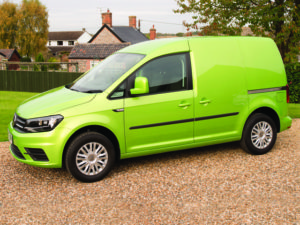As the market looks for alternatives to diesel, Dan Gilkes tries two petrol options from Volkswagen.

With increasing pressure forcing companies away from diesel, there remain few options for van operators. Volkswagen is looking to change that. While VW will still offer you a Caddy or Caddy Maxi with the 2.0-litre diesel engine, in three power ratings plus a Blue Motion model, you can also choose from three separate petrol motors now.
They start with a 1.2-litre, offering 84hp and 160Nm of torque, on Caddy only. Somewhat confusingly the next powerful engine is also the smallest, a three-cylinder 1.0-litre delivering 102hp and 175Nm of torque, which can be had on Caddy and Caddy Maxi. Topping the petrol line-up is a 1.4-litre TSi, with a healthy 125hp and 220Nm of torque, again available in both bodies.
In terms of fuel consumption, both the 1.2-litre and the 1.4-litre engines promise around 47-49mpg depending on model, with CO2 emissions of 131-136g/km. The 1.0-litre is the real performer, with 50.4-51.4mpg and 125-128g/km.
Those figures compare favourably with the mid-range 102hp diesel engine, which delivers 55.4-60.1mpg and 124-133g/km.
Apart from the 102hp engines it is hard to compare power outputs exactly, but like for like vans are between £1,000 and £2,000 less expensive to purchase with petrol power. Plus, you don’t have to top up with AdBlue or worry about DPF issues, which should make the petrol engines a popular choice for urban users.
Both the 1.2-litre and the 1.0-litre petrol engines come with five-speed manual gearboxes, while the 1.4-litre has a six-speed box. It can also be specified with a seven-speed DSG automatic for an additional £1,500.
We’ve tried both the 1.0-litre and the 1.4-litre engines, in Caddy and Caddy Maxi respectively. Given that both either match or exceed the power available in the original Golf GTi, it will come as little surprise that they are sprightly performers.
The most noticeable difference to their diesel counterparts is the lack of engine noise, with the 1.0-litre in particular pulling away almost like an electric vehicle. Both vans have decent acceleration and cruise well, with the larger engine’s six-speed manual box making it the nicer experience at higher speeds.
Gross weights are slightly lower for the petrol vans, though with lighter engines on board, payloads are marginally higher. Towing allowances take a slight hit though, unless you opt for the 1.4-litre with DSG box, which retains a 1.5-tonne towing limit.
The basic Startline trim is only available with the two smaller engines on Caddy and with the 1.0-litre on Caddy Maxi. Mid-range Trendline trim can be paired with the 1.0-litre and the 1.4-litre on Caddy and with the largest engine only on the Caddy Maxi. As befits its range-topping position, the Highline trim is only offered with the 1.4-litre motor, with a choice of transmissions.
A number of manufacturers have offered smaller vans with petrol engines over the last few years, with few takers. However, the changing attitude towards diesel, may make more companies take a look. With these Caddys, petrol is certainly not the poor cousin.
What we think
With similar mpg and CO2, a lower purchase price and no AdBlue, the petrol vans have a lot to recommend them.

